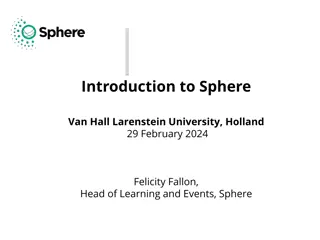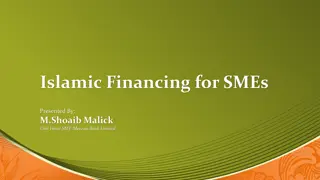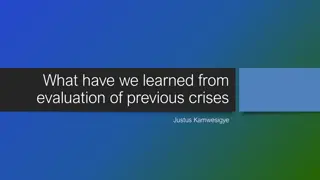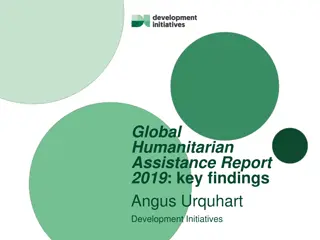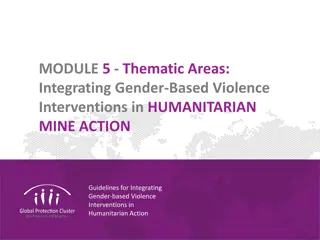Renegotiation of Donor Conditions for Humanitarian Financing
This interim presentation outlines the objective of renegotiating donor requirements to reduce burden in humanitarian financing. Findings focus on the severity of conditions, methodology used, respondents involved, general findings, and top conditions affecting humanitarian principles. The document aims to present insights to the IASC Task Team on Humanitarian Financing.
Download Presentation

Please find below an Image/Link to download the presentation.
The content on the website is provided AS IS for your information and personal use only. It may not be sold, licensed, or shared on other websites without obtaining consent from the author.If you encounter any issues during the download, it is possible that the publisher has removed the file from their server.
You are allowed to download the files provided on this website for personal or commercial use, subject to the condition that they are used lawfully. All files are the property of their respective owners.
The content on the website is provided AS IS for your information and personal use only. It may not be sold, licensed, or shared on other websites without obtaining consent from the author.
E N D
Presentation Transcript
DONOR CONDITIONS DONOR CONDITIONS Objective 2.1 Renegotiate donor requirements or conditions Renegotiate donor requirements or conditions that contribute to reducing the burden that contribute to reducing the burden Interim presentation of findings to the IASC Task Team on Humanitarian Financing 24 July 2015 HFTT workplan stream co-led by WFP and UNFPA - This document is designed as support to the oral presentation. As the findings are still draft, please do not circulate beyond IASC HFTT members. 1
Introduction Introduction Introduction Introduction This update only concentrates on steps undertaken since the last update to the IASC HFTT in May. 2
Methodology used Methodology used The impact of conditions were defined from a 1 to 5 severity and averaged into three quartiles in order to prioritise the top quartile as being the top conditions. Objective: Focus only on the conditionalities with the most significant impact Quartiles Severity of Conditionalities 5 Significant impact (Presents constraints to adequately fulfilling organizational objectives) THIRD Quartile 4 Large impact Medium impact 3 MEDIAN Quartile Small impact 2 FIRST Quartile Little impact 1 3
Respondents: 13 in total (8 UNOs and 5 NGOs) Respondents: 13 in total (8 UNOs and 5 NGOs) UN Agencies NGOs Handicap Int. Oxfam Action Aid Christian Aid CAFOD FAO UNICEF IOM WFP UNFPA OCHA WHO UNHCR After a number of extensions, the survey was closed on 30 June 2015 4
General Findings (I) General Findings (I) Emerging trends from top conditions out of 14 ranked by severity of conditions. Quartiles Conditionality Financial Restrictions Earmarking HIGH IMPACT Reporting Risk Management Due Diligence Counter-terrorism Limited Predictability MEDIUM IMPACT Disclosure/Transparency Value for Money Anti-corruption/fraud/misuse of funds Visibility Environmental impact/Climate change Lobbying SMALL IMPACT Restrictions on staff with donor country s nationality 5
Conditionality Humanitarian Principles Details Percentage of Impact Level Unspent balances to be returned rather than used for similar activities- The probability of having to refund is significantly higher than the probability that donors agree on reprogramming Lack of flexibility, predictability and timely funding: 1,2,8 Financial Restrictions 19% Spending deadlines (sometimes with no possibility of no-cost extensions) Disbursement delayed or split up into tranches Organisations have to request funding to cover immediate needs Lack of flexibility, predictability and timely funding: 1,2,8 Project/Activity Earmarking 16% Geographic Area Aid based on need assessment: 2,8 Flexibility, predictability, excessive reporting requirements: 1,8 Additional reporting requested which differs from the standardised reporting format Reporting 10% Disbursement from multi-year agreements are subject to approval of the reports by the donor Request for aid diversion reports Request for reporting on burn rates Risk Management 10% Lack of flexibility: 1,2,8 Donors request to update the risk management plan provided as part of the Project Proposal at least quarterly, based on performance information assessments Donors reserve right to stop transfers, claim repayment if contractual obligations are not met or if it emerges that funds are not being usedfor the agreed project 6 Due Diligence 8%
Additional observations: Additional observations: The top 5 conditionalities are closely followed by the next five: Counter-terrorism Limited predictability Disclosure/transparency Value for money Anti-corruption Because of the small difference in cumulative totals for the following 5 conditionalities, the suggestion is to also cover the next 5 in the messaging. If disaggregated by UNO and NGO, the only real difference is the higher effect of disclosure/transparency on NGOs, but otherwise the results are quite consistent for the two groups. 7
Top 3 conditionalities among the top 10 donors Top 3 conditionalities among the top 10 donors (*donor names are listed in alphabetical order) (*donor names are listed in alphabetical order) Organization Conditionality Details Limited Predictability Limited predictability and multi-year funding for most donors, which hinders the development of resilience and government capacity-building programmes Canada Earmarking Project/Activity Counter-terrorism Standard counter-terrorism language cleared by legal departments Limited predictability and multi-year funding for most donors, which hinders the development of resilience and government capacity-building programmes Limited Predictability Financial Restrictions EU Request to co-fund 20% funded projects Counter-terrorism Request to ban certain groups from implementing or benefitting from the project Donors reserve right to stop transfers, claim repayment if contractual obligations are not met or if it emerges that funds are not being used for the agreed project Limited predictability and multi-year funding for most donors, which hinders the development of resilience and government capacity-building programmes Risk Management Limited Predictability Germany Earmarking Project/Activity Earmarking Project/Activity Japan Financial Restrictions Spending deadlines (sometimes with no possibility of no-cost extensions) Earmarking Geographic area 8
Top 3 Top 3 conditionalities conditionalities among the top 10 donors among the top 10 donors * * (*donor names are listed in alphabetical order) (*donor names are listed in alphabetical order) Organization Conditionality Details Earmarking Project/Activity Disbursement from multi-year agreements are subject to approval of the reports by the donors Limited predictability and multi-year funding for most donors, which hinders the development of resilience and government capacity-building programmes Donors reserve right to stop transfers, claim repayment if contractual obligations are not met or if it emerges that funds are not being used for the agreed project The use of the contribution and the management of funds shall comply with the professionally accepted book-keeping rules and practices Reporting Netherlands Limited Predictability Risk Management Norway Anti-corruption/fraud/misuse of funds Earmarking Project/Activity Donors reserve right to stop transfers, claim repayment if contractual obligations are not met or if it emerges that funds are not being used for the agreed project Disbursement from multi-year agreements are subject to approval of the reports by the donors Risk Management Reporting Switzerland Earmarking Project/Activity Unspent balances to be returned rather than used for similar activities. The probability of having to refund is significantly higher than the probability that donors agree on reprogramming Financial Restrictions Sweden Due Diligence Each contribution shall be subject to internal and external auditing procedures Donors reserve right to stop transfers, claim repayment if contractual obligations are not met or if it emerges that funds are not being used for the agreed project Risk Management 9
Top 3 conditionalities among the top 10 donors * Top 3 conditionalities among the top 10 donors * (*donor names are listed in alphabetical order) (*donor names are listed in alphabetical order) Organization Conditionality Details Reporting Additional reporting requested which differs from the standardised reporting format Counter-terrorism UK Request to ban certain groups from implementing or benefitting from the project Due diligence Robust due diligence process-per theme, per humanitarian action + desk review Counter-terrorism Standard counter-terrorism language cleared by legal departments Donors reserve right to stop transfers, claim repayment if contractual obligations are not met or if it emerges that funds are not being used for the agreed project Risk Management USA Counter-terrorism Request to ban certain groups from implementing or benefitting from the project Limited Predictability Limited predictability and multi-year funding for most donors, which hinders the development of resilience and government capacity-building programmes CERF * Earmarking Project/Activity Financial Restrictions Staff costs limited to 10%, staff costs limited also for more labour-intensive activities which are treated the same as other non-labour intesive activities 10
Draft headline messages Draft headline messages to be developed to be developed Financial Restrictions affect the overall efficiency of recipient organizations they slow down implementation and increase overall transaction costs. Earmarking affects costs effectiveness by inhibiting the equitable distribution of resources increasing risks for over/under funding beneficiaries caseloads, impacting programme decisions. Heavy reporting requirements can significantly affect transaction costs and can absorb human and other resources that could be perhaps better spent on implementation. Risk management will push organizations towards a more risk-averse mode of operation rather than one governed by needs on the ground. Due diligence processes can significantly delay the implementation of humanitarian activities. Limited predictability prevents more equitable planning, lower return on investment by limiting negotiating power with partners (including suppliers) as budgets/procurement activities are carried out within a short funding horizon. A lack of multi-year funding also prevents organization from stabilizing outcome gains as the continuity of implemented activities cannot be guaranteed. 11
Suggestions Suggestions for discussion for discussion 1. Steer away from providing too much detail of the survey to donors which might detract from end result we want to achieve. Concentrate on messaging on how conditionalities affect humanitarian operations (evidence) and why we would need to change them. Further examples to substantiate impact of conditionalities will be needed are we able to provide them and how? Key audiences: SG High Level Panel, GHD (September), WHS 3. Continue with consortium-to-consortium approach for now. 4. Focus on top 5 or more? Even if little scope for improvement has been suggested? 5. The analysis so far does not suggest significant differences between UN and NGOs so the suggestions is to continue treating it as one group. 6. Should we share with donors the top 3 conditionalities? With each individually or for the group? Would we need to cross-check the findings with colleagues handling these donor portfolios? 2. 3. 12




